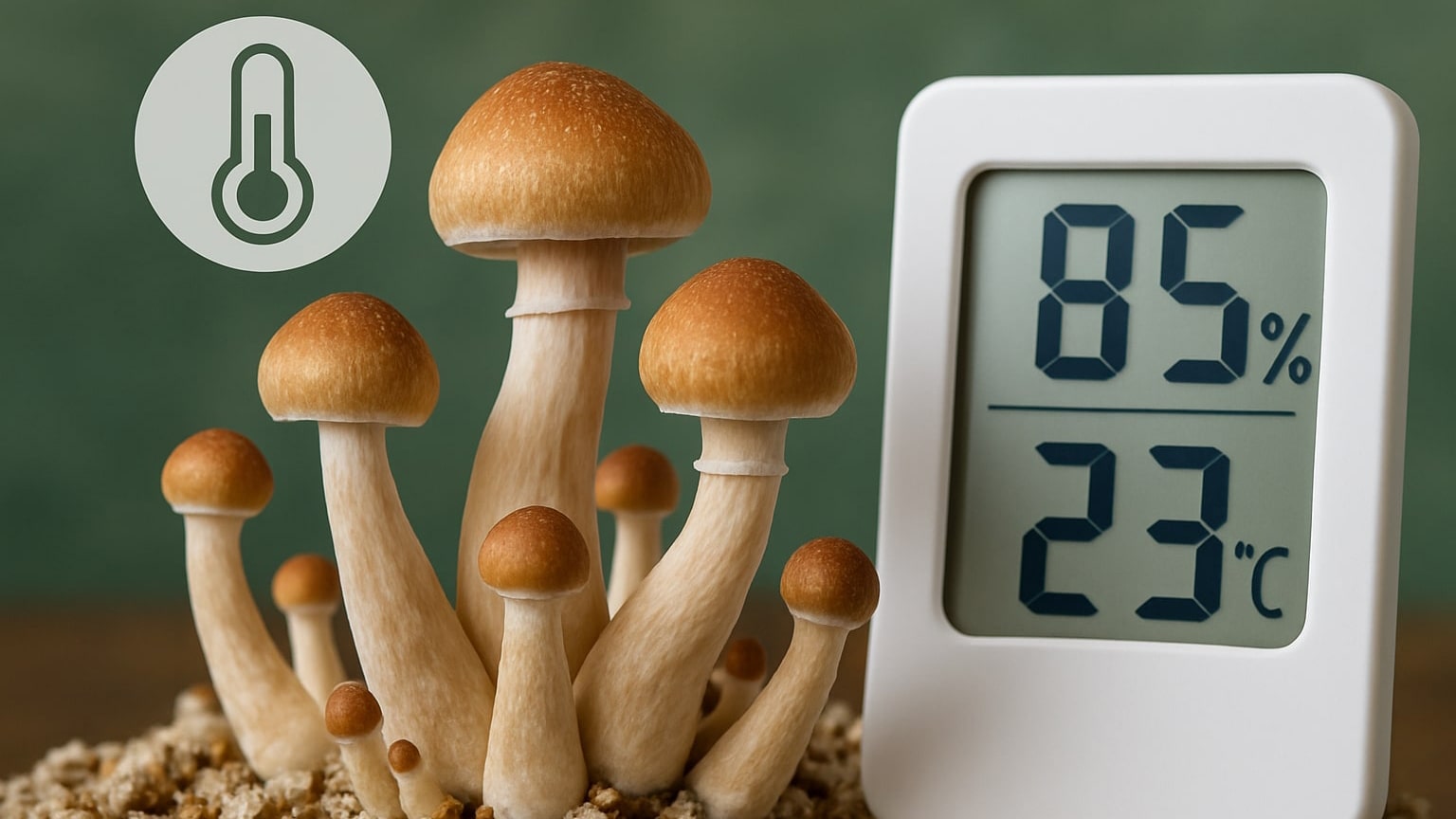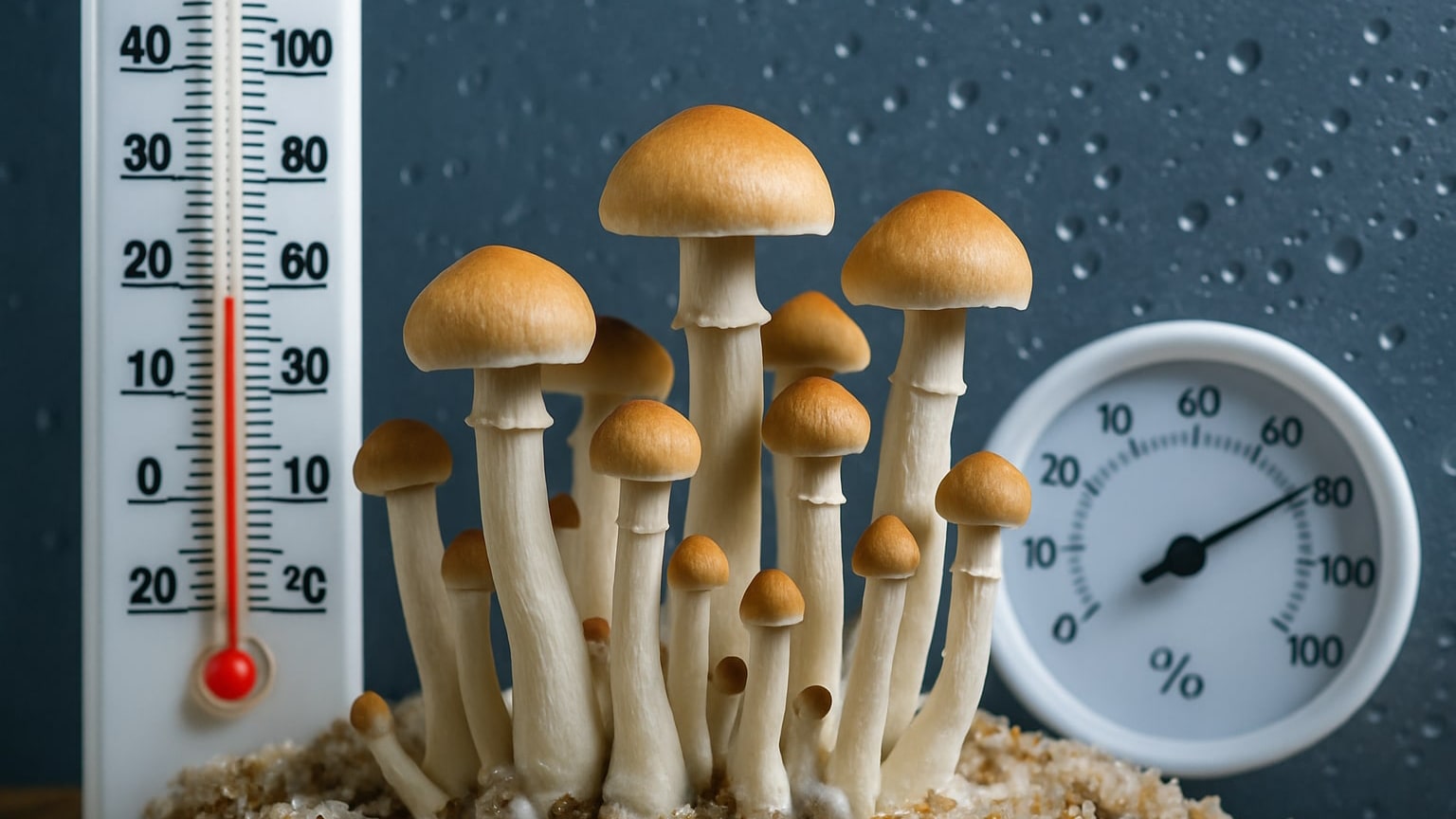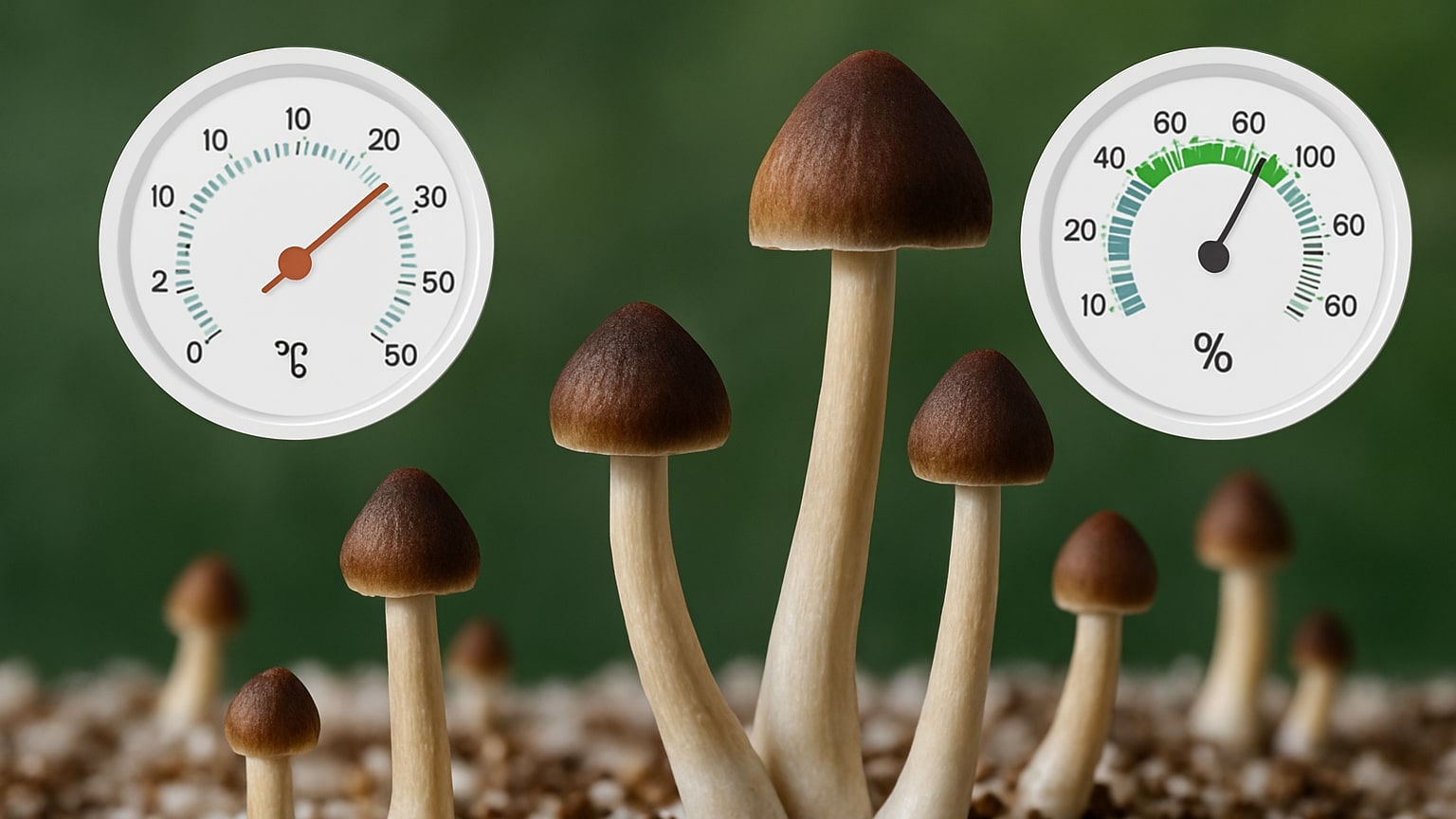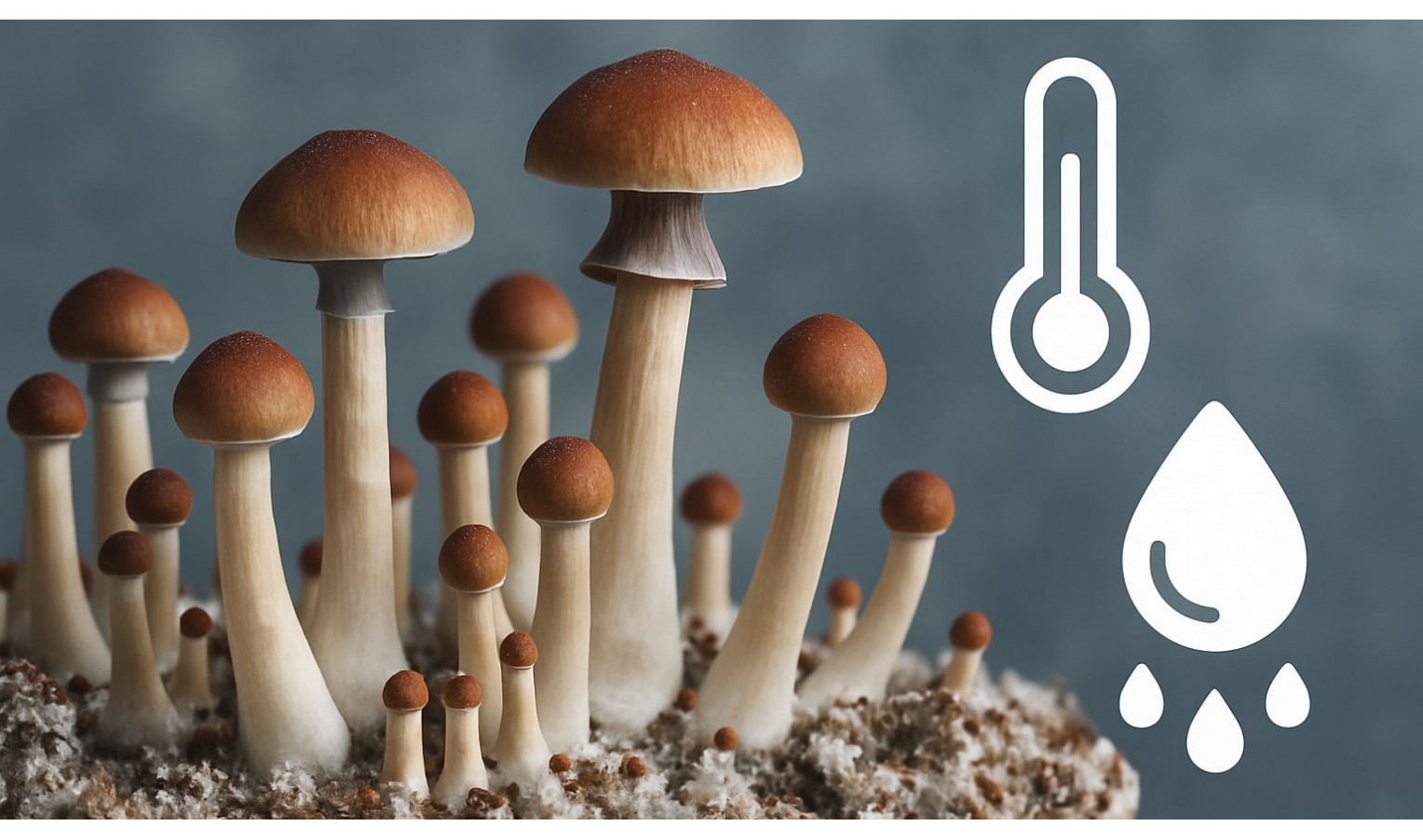For successful mushroom cultivation at home, especially sensitive mushrooms such as psilocybin mushrooms, it is important to understand how critical temperature is for psilocybin mushrooms. Temperature affects not only the growth rate of the mycelium, but also the quality of fruiting.
Temperature conditions: the basis for successful cultivation of psilocybin mushrooms

When growing psilocybin mushrooms, it is especially important to maintain the correct temperature. The temperature for psilocybin mushrooms directly affects the rate of mycelium development and the subsequent formation of fruiting bodies. Each stage of the mushroom life cycle requires its own specific conditions, and neglecting the temperature can lead to a poor harvest or a complete lack of fruiting.
In the first stage, when the substrate is colonized, the optimal incubation temperature for the mycelium is considered to be between 24–27°C. This is the period when the fungal mycelium germinates and fills the entire space of the nutrient medium. Raising the temperature above 30°C can be disastrous — the mycelium overheats and begins to die off. At the same time, too low a temperature (below 22°C) slows down the process dramatically, which increases the risk of infection by harmful microorganisms.
It is important to understand that successful incubation is impossible without preparing the medium. That is why sterilization of substrates plays a key role. Only a completely disinfected substrate will protect the mycelium from mold, bacteria, and competing fungi, especially in conditions of elevated temperature, when pathogens develop faster.
After the incubation period is complete, the fruiting phase begins. Here, a change in temperature is necessary. The temperature during mushroom fruiting should be reduced to 20–23°C. This change mimics the natural conditions of climate change, signaling to the mycelium that fruiting has begun. This is the optimal temperature for mushrooms in the final stage.
At home, a mushroom grow box with built-in heating and cooling systems helps to maintain the desired temperature balance. This equipment allows you to create a stable microclimate for mushrooms, which is critically important both during incubation and during the formation of caps. Temperature fluctuations are unacceptable — even a short-term deviation can negatively affect the quality of the harvest..
Temperature conditions: the basis for successful cultivation of psilocybin mushrooms

Humidity is the second most important parameter after temperature for successful mushroom cultivation at home. Without the proper level of moisture, even with an ideal substrate and temperature, psilocybin mushrooms will not be able to develop fully. It is especially important to control humidity at every stage of the life cycle, from incubation to fruiting.
Modern psilocybin mushroom cultivation systems allow you to effectively manage this parameter, including automatic humidification, air humidity control, and air circulation. However, even when using technology, it is important to understand the basic principles.
1. Humidity during the mycelium incubation stage
During the substrate colonization stage, the incubation humidity of the mycelium should be between 90 and 95%. This environment stimulates spore germination and active mycelium growth. To achieve this, it is necessary to:
- use a sterile and moistened substrate;
- maintain the airtightness of the incubation container;
- make sure there is no condensation build-up, which can lead to mold growth.
2. Humidity during the fruiting phase
When the mycelium has completely colonized the substrate, it is time to start the process of fruit body formation. This requires slightly different parameters. The optimal humidity for mushrooms at this stage is 85 to 95%. It is important that the air is saturated with moisture and that the substrate remains moist but not over-moistened.
This will help:
- humidity in the fruiting chamber, regulated by a humidifier or manually by spraying;
- hygrometer for accurate moisture level control;
- ventilation to prevent air stagnation and droplet formation on the surface.
3. How to control humidity for mushrooms
Maintaining the right level of humidity is not a one-time task, but an ongoing process. To simplify the task, especially in a limited space, you can use:
- automatic humidifiers with timers and sensors;
- manual sprayers for small volumes;
- moisture-retaining materials in the bottom layer of the chamber (e.g., perlite or vermiculite).
Some psilocybin mushroom cultivation systems already include built-in humidifiers and sensors that allow for the automation of most of the care process. This is particularly relevant for long fruiting periods or when cultivating several containers simultaneously.
Microclimate and care: how to create a stable environment for mushrooms

Creating the right microclimate for mushrooms involves not only temperature and humidity, but also many other factors: ventilation, cleanliness, lighting, and, of course, the quality of the nutrient medium. All of these factors together ensure the full development of the mycelium and the formation of healthy, powerful fruiting bodies.
One of the key stages is the preparation of the substrate for cultivation. Without a properly moistened, sterile, and nutritious substrate, it is impossible to achieve stable growth. Mixtures based on coconut fiber, vermiculite, grain, manure, and other components are used. Not only the composition is important, but also the pH level, as well as complete sterilization of the substrates, which eliminates the risk of contamination by competing microorganisms.
Key microclimate parameters
Below is a table with optimal indicators for different stages of psilocybin mushroom cultivation:
| Parameter | Incubation stage | Fruiting stage |
| Temperature | 24–27°C | 20–23°C |
| Air humidity | 90–95% | 85–95% |
| Ventilation | Minimal, passive | Active, 2–4 airings per day |
| Lighting | Not required | Diffused light 12/12 |
| Duration of the stage | 2–3 weeks | 7–14 days |
Caring for mushrooms: important recommendations
- Ventilation plays a key role in mushroom cultivation during the fruiting stage. When CO₂ accumulates, the fruiting bodies become deformed, stretch upward, and yield decreases. It is best to use grow boxes with fans or to open the chamber regularly.
- Lighting should be soft and indirect. Psilocybin mushrooms require 12 hours of light per day. LEDs with a neutral spectrum (4000–6500K) are suitable.
- Cleanliness is the key to success. All tools and surfaces should be treated with an alcohol solution. Hand contact should be minimal. This is especially important in closed psilocybin mushroom cultivation systems.
- Regular monitoring — measure parameters using thermometers, hygrometers, and CO₂ sensors. It is better to respond to deviations immediately than to deal with the consequences later.
Conclusion
The right microclimate is the foundation for successfully growing psilocybin mushrooms. Maintaining optimal temperature and humidity, carefully preparing the growing substrate, and controlling ventilation and cleanliness are all critical at every stage. The use of modern psilocybin mushroom cultivation systems, including grow boxes and automatic humidifiers, helps to create stable conditions even at home. By adhering to these parameters, you can not only increase yield, but also ensure the health and quality of the mushrooms.
It's important!!! This article is written for informational purposes. We do not promote the use of illegal substances.

